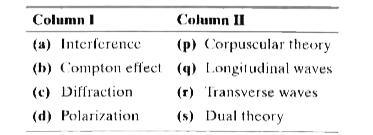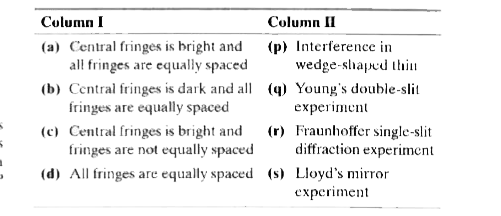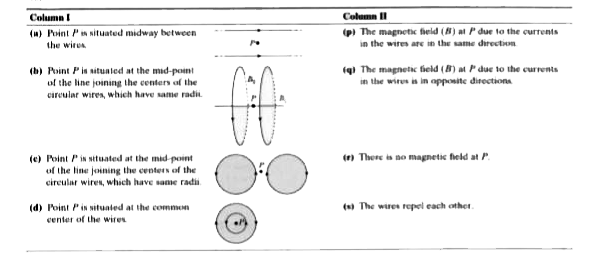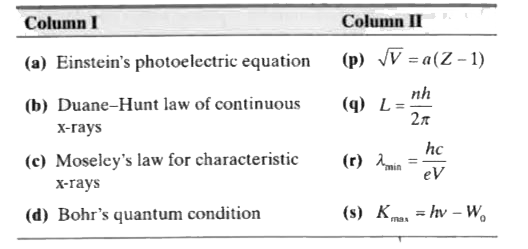Match the statements in Column I labeled as (a), (b), (c), and (d) with those in Column II labeled as (p), (q), (r), and (s).Any given statement in Column I can have correct matching with one or more statements in Column II.
None of these
The correct Answer is:A, B, C, D
Topper's Solved these Questions
- ELECTROMAGNETIC WAVES Book:RESNICK AND HALLIDAYChapter:ELECTROMAGNETIC WAVES Exercise:PRACTICE QUESTIONS (Integer Type)
Explore 3 Videos
- ELECTROMAGNETIC WAVES Book:RESNICK AND HALLIDAYChapter:ELECTROMAGNETIC WAVES Exercise:PRACTICE QUESTIONS (Linked Comprehension)
Explore 2 Videos
- ELECTROMAGNETIC OSCILLATIONS AND ALTERNATING CURRENT Book:RESNICK AND HALLIDAYChapter:ELECTROMAGNETIC OSCILLATIONS AND ALTERNATING CURRENT Exercise:Practice Questions (Integer)
Explore 7 Videos
- FLUIDSBook:RESNICK AND HALLIDAYChapter:FLUIDSExercise:PRACTICE QUESTIONS (Integer Type )
Explore 5 Videos
Similar Questions
The velocity of electromagnetic waves in free space is 3×108 m/s. Whal is the frequency (in MHz) of the wavelength of vaJue 150 m?
View SolutionElectromagnetic radiation is emitted by accelerating charges. The rate at which the e nergy is emitted from an accelerating charge that has charge q and acceleration a is given by dE/dt = q2a2/6πε0c3 , where c is the speed of light. A proton and an electron of kinetic energy 6 Me V is traveling in a particle accelerator in a circular orbit of radius 0.75 m.
What fraction of its energy does a proton emit per second?
View SolutionAn a.c source of frequency 1000Hz is connected to a coil of 200πmH and negligible resistance. If effective current through the coil is 7.5mA, what is the voltage (in volt) across the coil ?
View SolutionA soap bubble is blown to a diameter of 7 cm. if 36960 ergs of work is done in blowing if further find the new radius, if surface tension of the soap solution is 40 dynes/cm.
View SolutionColumn IColumn II(A)R/L(p)Time(B)C/R(q)Frequency(C)E/B(r)Speed(D)√ε0μ0(s)None
View Solutionमैक्सवेल की सैमीकरणे व लारेंज बल का नियम दिया गया है -
(I)∮→E.D→A=q∈0
(ii)∮→B.D→A=0
(iii)∮→E.D→l=−ddt∫s→B.D→A
(iv)∮→B.d→l=μ0Ic+μ0∈0ddt∫s→E.d→A
लॉरेज बल =→F=q(→E+→v×→B)
इन सेमीकरणे से सम्बन्धित निम्न से उतर दो -
कौन - कौन से समीकरणों →E ओर →B के स्त्रोत प्रदर्शित करती है ओर कौन सी नहीं ? आवेश रहित होने की स्थिति में समीकरणों का क्या प्रारूप होगा ।
View SolutionThe maxwell’s equation :
∮→B.→dl=μ0(i+ɛ0.dϕEdt) is a statement of -
View SolutionIn each question, there .is a table having 3 columns and 4 rows. Based on the table, there are 3 questions. Eac!h question bas 4 options (a), (b), (c) and (d), ONLY ONE of these four options is correct.
In the given table, Column I shows different laws in electromagnetic theory, Column II shows the related physica l quantities and Column III shows the equations related to the different laws.
Column IColumn IIColumn II(I) Gauss's law(i)Magnetism (J)∮→B.d→s=μ0ε0dϕEdt+μ0dqdt(II)Ampere's law(ii)Current (K) ∮→B.d→A=0(III)Gauss's law (iii)Induction (L)∮→E.d→s=dϕBdt(IV)Faraday's (iv)Electricity (M)∮→E.d→A=qε
In which law does the charge create diverging electric fields?
View SolutionIn each question, there .is a table having 3 columns and 4 rows. Based on the table, there are 3 questions. Eac!h question bas 4 options (a), (b), (c) and (d), ONLY ONE of these four options is correct.
In the given table, Column I shows different laws in electromagnetic theory, Column II shows the related physica l quantities and Column III shows the equations related to the different laws.
Column IColumn IIColumn II(I) Gauss's law (i) Magnetism (J)∮→B.d→s=μ0ε0dϕEdt+μ0dqdt(II)Ampere's law(ii)Current (K) ∮→B.d→A=0(III)Gauss's law (iii)Induction (L)∮→E.d→s=dϕBdt(IV)Faraday's (iv)Electricity(M)∮→E.d→A=qε
Jn which law there are no magnetic monopoles invo lved?
View SolutionIn each question, there .is a table having 3 columns and 4 rows. Based on the table, there are 3 questions. Eac!h question bas 4 options (a), (b), (c) and (d), ONLY ONE of these four options is correct. In the given table, Column I shows different laws in electromagnetic theory, Column II shows the related physica l quantities and Column III shows the equations related to the different laws. {:("Column I" , "Column II" , "Column II"),((I)" ""Gauss's law (i)", " ""Magnetism "" "(J),oint vecB.dvecs=mu_(0)epsilon_(0)(dphi_(E))/(dt)+mu_(0)(dq)/(dt)),((II)"Ampere's law" ,(ii) "Current " ,(K)" "ointvecB.dvecA=0),((III) "Gauss's law " (iii),"Induction " " "(L),ointvecE.dvecs=(dphi_(B))/(dt)),((IV) "Faraday's "(iv),"Electricity" (M),ointvecE.dvecA=(q)/(epsilon)):} In which law currents or changing electric fi elds(E's) make circulating magnetic fields (B's)?
View SolutionMatch the statements in Column I labeled as (a), (b), (c), and (d) with those in Column II labeled as (p), (q). (c), and (s). Any given statement in Column I can have correct matching with one or more statements in Column II.
Match the property with the concept it is based on.

View SolutionMatch the statements in Column I labeled as (a), (b), (c), and (d) with those in Column II labeled as (p), (q). (c), and (s). Any given statement in Column I can have correct matching with one or more statements in Column II.
Match the observation given in Column I with the experiments given in Column II.

View SolutionMatch the statements in Column I labeled as (a), (b), (c ), and (d) with those in column II labeled as (p), (q), (r ), and (s). Any given statement in column I can have correct matching with one or more statements in Column II.
View SolutionMatch the statements in Column I labeled as (a), (b), (c ), and (d) with those in column II labeled as (p), (q), (r ), and (s). Any given statement in column I can have correct matching with one or more statements in Column II.

View SolutionMatch the statements in Column I labeled as (a), (b), (c), and (d) with those in Column II labeled as (p), (q), (r), and (s). Any given statement in Column I can have correct matching with one or more statements in Column II.

View Solution
